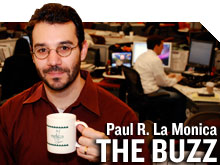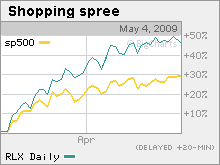Are consumers back from the dead?
Consumer spending rose 2.2% in the first quarter and shares of many retailers are on fire, leading some to expect a quick economic recovery. Not so fast.

 |
| Retail stocks have been on fire since the market hit its low point in March. The S&P Retail Index has outperformed the broader market's huge gains by a wide margin. |
NEW YORK (CNNMoney.com) -- This Thursday is D-Day for the nation's biggest banks. That's when regulators will release the eagerly awaited results of the stress tests conducted on the 19 largest financial institutions.
But that's not the only important news that will be out that day. It's also when most top retailers will be releasing sales figures for April.
Investors should pay close attention because it will be the first real glimpse into whether consumers really are feeling more confident about the economy.
Even though the stock market has rallied sharply in the past two months on hopes that the recession may soon be over, it's still unclear whether the economy can quickly bounce back or if the road to recovery will be a slow, tough slog.
One thing is certain, though. For the economy to rebound, consumers are going to have to lead the way. Consumer spending makes up about two-thirds of the nation's overall economy.
There are some tentative signs that consumers are no longer paralyzed by fear as they were after the collapse of Lehman Brothers in September.
Although the government reported last week that the economy dipped at an annualized pace of 6.1% in the first quarter, personal consumption expenditures rose 2.2%. That's encouraging since it comes on the heels of consumer spending declines of about 4% in both the third and fourth quarters of last year.
"Barring some nasty surprise, the negative adjustment in consumer spending is largely over. The big declines are behind us," said Chris Probyn, chief economist with State Street Global Advisors in Boston.
Investors are definitely betting that the consumer is back. The S&P Retail Index is up nearly 45% since the market's low point in early March, outperforming the broader S&P 500's gain of about 30%. Shares of some prominent retailers, including Macy's (M, Fortune 500) and J.C. Penney (JCP, Fortune 500), have doubled.
Still, some fear that investors may be getting ahead of themselves. Are consumers, which have begun to save more in the wake of last fall's credit crisis, really going to return to their spendthrift ways? Is there really that much pent-up demand for goods?
There is a good chance that consumers really have learned their lesson and that people will stop relying so much on debt.
For example, Paul Nolte, director of investments for Hinsdale Associates, a money-management firm based in Hinsdale, Ill., said that when he asks a lot of clients what they would do if someone gave them an extra $5,000, most indicated they would pay down debt and put money into savings.
"There is a shift in mentality. Consumers will spend when they have to. But you won't see that level of debt-driven spending like you did in the past," said Nolte.
And if people are more cautious with their money, that's likely to mean that the economy will take longer to start growing again than the market now seems to think.
"People are looking for the light at the end of the tunnel, but investors are kidding themselves if they think this will be a normal quick V-shaped recovery," said Stephanie Giroux, chief investment strategist with TD Ameritrade. "There are excesses that built up over 20 to 30 years. That's not going to unwind in a one to two year period."
Retailers likely endured another tough month in April. According to estimates from Thomson Reuters, same-store sales are expected to be flat. And if you exclude the expected 3% increase from Wal-Mart (WMT, Fortune 500), which has a big impact on the overall results, sales are forecast to be down 3%.
Department store chains Kohl's is expected to post 7% declines in sales at stores open at least a year, while analysts are projecting a 9% drop for JW Nordstrom (JWN, Fortune 500).
It also goes without saying that consumer spending patterns are tied closely to the health of the job market. And there are no signs that companies are going to hire en masse anytime soon.
The government will release employment figures for April on Friday. Economists are forecasting a loss of 620,000 jobs and an increase in the unemployment rate to 8.9% from 8.5% in March.
And with many banks still reluctant to lend, it may be tough for consumers to spend more -- even if they wanted to. That means that any boost to spending is likely to be more modest.
"Will consumers be able to increase spending 3% to 4% like they were heading into this recession? No," said Tom Higgins, chief economist with Payden & Rygel, a Los Angeles-based money management firm. "Increases are likely to be in the 1% to 2% range. You may get temporary pops but that is not going to be sustained given limited access to credit."
Now don't get me wrong. If consumers moderately increase their spending, that's great news for the economy in the long-term. That's because it will lessen the chances of another credit bubble-induced recession as ugly as this one taking place anytime soon.
But the market's big bounce does not seem to be predicated on hopes of economic stabilization over the long haul, but a rapid rebound by the end of the summer.
That's why the April retail sales numbers are so crucial. We already know that spending was up in the first quarter. Has it carried over into the second quarter? If a couple of big name retailers report better-than-expected sales for April on Thursday, then that could be a sign that this market rally is for real.
If not, hopes of an imminent recovery could fade. Nolte worries that earnings estimates for many companies may be too high because of unreasonable hopes about how much people will really spend.
"Historically, you should never bet against the consumer. But this time might finally be the time," Nolte said. ![]()

